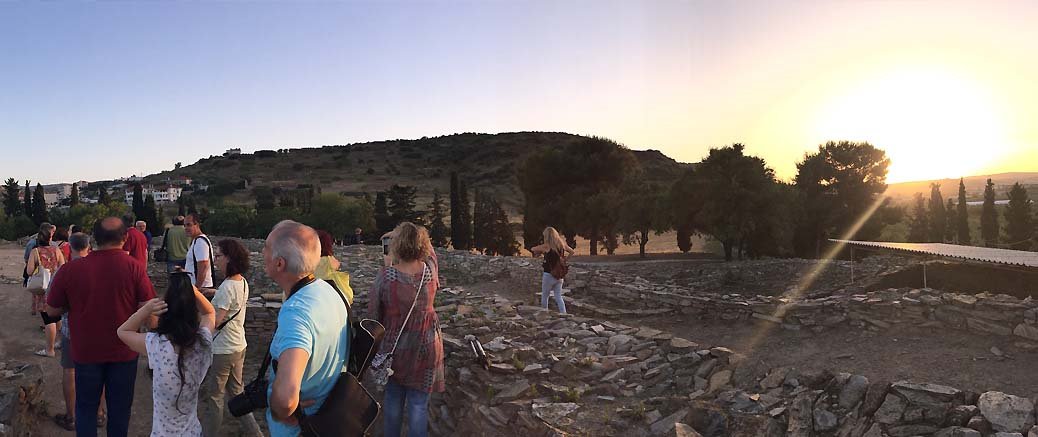Volos is not particularly known for archaeoastronomy sites. However, there are things of interest:
The Centaurs
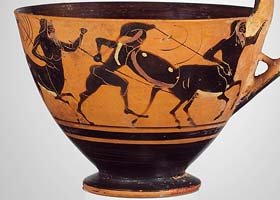 Pilion rises impressively above Volos. This is the mountain of the centaurs, half men, half horses. Two Centaurs appear as constellations in the night sky: Centaur (associated with the most famous of the Centaurs, the wise Chiron) and Sagittarius (the archer Centaur aiming at Scorpio).
Pilion rises impressively above Volos. This is the mountain of the centaurs, half men, half horses. Two Centaurs appear as constellations in the night sky: Centaur (associated with the most famous of the Centaurs, the wise Chiron) and Sagittarius (the archer Centaur aiming at Scorpio).
The Argonauts
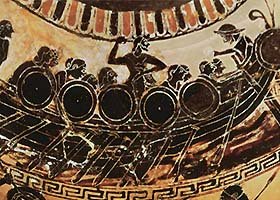 The story of the Argonauts is well known. Such journies could only be accomplished with the aid of navigators, and navigators use the stars to find their route. Anyone interested in taking up this study for SEAC?
The story of the Argonauts is well known. Such journies could only be accomplished with the aid of navigators, and navigators use the stars to find their route. Anyone interested in taking up this study for SEAC?
The tholos tombs in Dimini
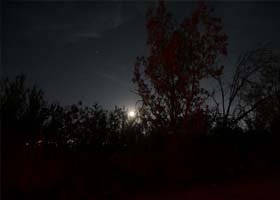 Two tholos have been excavated in Dimini. Lamiospito is dated in the 14th c. BC; Toumba is dated in the 13th c. BC. Curiously enough, the Toumba is associated in the local culture with the summer solstice sunset; Lamiospito looks as if it is oriented to the northern major lunistice moonrise. Preliminary results do not verify these claims; a presenation is planned for SEAC 2026. A visit to the site will be arranged for those interested.
Two tholos have been excavated in Dimini. Lamiospito is dated in the 14th c. BC; Toumba is dated in the 13th c. BC. Curiously enough, the Toumba is associated in the local culture with the summer solstice sunset; Lamiospito looks as if it is oriented to the northern major lunistice moonrise. Preliminary results do not verify these claims; a presenation is planned for SEAC 2026. A visit to the site will be arranged for those interested.
The cave of Chiron
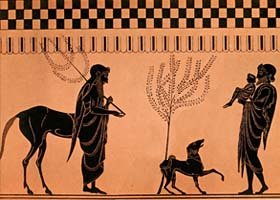 Chiron, the wise Centaur that taught Achilles lived on the mount Pilion. There are a couple caves that are supposed to be his residence, but only one has archaeological evidence from antiquity. This is located at the very top of the mountain, a perfect place to site the heliacal rise of Sirius. Yes, ancient sources connect the dog star with the cult of Chiron. A presentation is planned for SEAC 2026.
Chiron, the wise Centaur that taught Achilles lived on the mount Pilion. There are a couple caves that are supposed to be his residence, but only one has archaeological evidence from antiquity. This is located at the very top of the mountain, a perfect place to site the heliacal rise of Sirius. Yes, ancient sources connect the dog star with the cult of Chiron. A presentation is planned for SEAC 2026.
The temple of Apollo Pagaseus
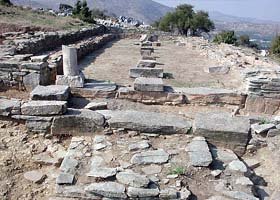 This temple of the archaic and classical period is situated at a saddle below the peak of the hill of Soros, west of Volos. It was excavated by our University between 2004 and 2008. The orientation of the temple has been associated with the events described in the Shield of Hercules by Aleksandra Bajić and Milan S. Dimitrijević (2021).
This temple of the archaic and classical period is situated at a saddle below the peak of the hill of Soros, west of Volos. It was excavated by our University between 2004 and 2008. The orientation of the temple has been associated with the events described in the Shield of Hercules by Aleksandra Bajić and Milan S. Dimitrijević (2021).
Basilica A in Nea Aghialos
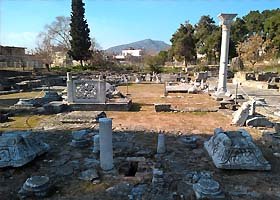 St. Demetrius basilica is dated in the 2nd half of the 5th c. AD. Themis Dallas has proposed that its orientation was capable of producing luminary effects on the feast day of the patron saint —even if he claims that this may have been accidental.
St. Demetrius basilica is dated in the 2nd half of the 5th c. AD. Themis Dallas has proposed that its orientation was capable of producing luminary effects on the feast day of the patron saint —even if he claims that this may have been accidental.
The Milies zodiac
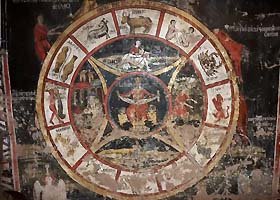 The church of Taxiarches in Miles, built in 1741, has a famous fresco of the "Whell of Life". This obscure iconography, features the ages of man, from birth to death, around a zodiac circle, with a personification of time in its center. Hidden behind a cabinet for a couple of centuries, it was rediscovered when the cabinet was removed for the renovation of the church! You will be able to see it for yourselves during the conference excursion.
The church of Taxiarches in Miles, built in 1741, has a famous fresco of the "Whell of Life". This obscure iconography, features the ages of man, from birth to death, around a zodiac circle, with a personification of time in its center. Hidden behind a cabinet for a couple of centuries, it was rediscovered when the cabinet was removed for the renovation of the church! You will be able to see it for yourselves during the conference excursion.
Old astronomy books
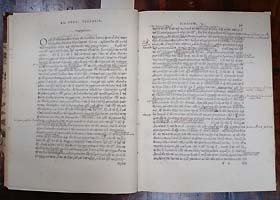 Milies and Zagora hold on to their historical libraries, with many 18th and 19th c. books, and even older manuscripts. Treasures include early books on astronomy, such as Notaras' Geographicals and Sphericals (1716), the greek translation of Laland's astronomy by Daniel Phillipides (1807) and Andrea Cellarius’ Harmonia Macrocosmica (2nd ed., 1708). You may browse through these during the conference excursion.
Milies and Zagora hold on to their historical libraries, with many 18th and 19th c. books, and even older manuscripts. Treasures include early books on astronomy, such as Notaras' Geographicals and Sphericals (1716), the greek translation of Laland's astronomy by Daniel Phillipides (1807) and Andrea Cellarius’ Harmonia Macrocosmica (2nd ed., 1708). You may browse through these during the conference excursion.
